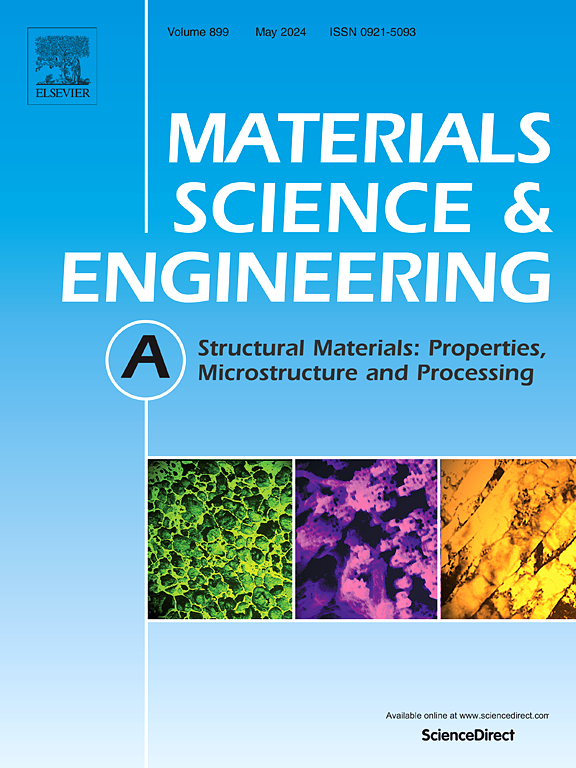放电等离子烧结对C103铌合金合金化、致密化及力学性能的影响
IF 6.1
2区 材料科学
Q1 MATERIALS SCIENCE, MULTIDISCIPLINARY
引用次数: 0
摘要
由于铌(Nb)合金的熔点相对较高,密度较低,而且与其他难熔金属相比,对间隙的耐受性更强,因此,人们对用于高温结构应用的铌(Nb)合金重新产生了兴趣。虽然过去有一些锻造铌合金是通过铸锭冶金工艺制成的,但铌合金的粉末冶金工艺尚未得到很好的发展。特别是粉末冶金加工中的最佳烧结条件、合金均匀化和致密化行为还没有得到很好的理解。本研究调查了 C103 铌合金(Nb-10Hf-1Ti;成分单位:重量百分比)在火花等离子烧结(SPS)过程中的合金化和烧结行为。目的是研究在明显低于凝固温度的条件下进行火花等离子烧结时的致密化、均质化和微观结构演变。合金几乎完全致密化,残留孔隙率极低(∼1.3 vol.%),屈服强度为 394 兆帕,抗拉强度为 458 兆帕,伸长率为 23%,平面应力断裂韧性(KQ)值为∼25 兆帕√m。强度水平明显高于锻造的 C103 合金。尽管本合金中的氧含量相对较高(2000 ppm),但与锻造合金相比,延展性仅略有降低(从 26% 降至 23%)。其强度水平也明显高于添加剂制造(EB-PBF 和 LB-PBF)的 C103 铌合金,且延展性没有任何损失。本文讨论了导致延展性和高断裂韧性水平的强化机制和微观结构因素。本文章由计算机程序翻译,如有差异,请以英文原文为准。
Effect of spark plasma sintering on alloying, densification and mechanical properties of C103 niobium alloy
There is a revival of interest in niobium (Nb) based alloys for high-temperature structural applications, due to their relatively higher melting point, lower density, as well as more tolerance to interstitials compared to other refractory metals. Although some wrought Nb alloys were made by ingot metallurgy in the past, powder metallurgy processing of Nb alloys has not been well developed. In particular, optimum sintering conditions, alloy homogenization and densification behavior in powder metallurgy processing have not been well understood. In this study, alloying and sintering behavior of C103 niobium alloy (Nb-10Hf-1Ti; composition in wt.%), during spark plasma sintering (SPS), have been investigated. The objective is to study the densification, homogenization, and microstructure evolution during spark plasma sintering at temperatures significantly below the solidus temperature. The alloy densified almost fully with very little residual porosity (∼1.3 vol. %) and exhibited 394 MPa yield strength, 458 MPa tensile strength, 23 % elongation and a plane stress fracture toughness (KQ) value of ∼25 MPa√m. The strength levels are significantly higher than that of the wrought C103 alloy. The ductility was found to be only slightly reduced (from 26 to 23 %) relative to the wrought version, even though the oxygen levels were relatively higher (>2000 ppm) in the present alloy. The strength levels are also significantly higher than those found in additive-manufactured (EB-PBF and LB-PBF) C103 niobium alloys and without any loss in ductility. The strengthening mechanisms as well as the microstructural factors that lead to the ductility and high fracture toughness levels are discussed.
求助全文
通过发布文献求助,成功后即可免费获取论文全文。
去求助
来源期刊

Materials Science and Engineering: A
工程技术-材料科学:综合
CiteScore
11.50
自引率
15.60%
发文量
1811
审稿时长
31 days
期刊介绍:
Materials Science and Engineering A provides an international medium for the publication of theoretical and experimental studies related to the load-bearing capacity of materials as influenced by their basic properties, processing history, microstructure and operating environment. Appropriate submissions to Materials Science and Engineering A should include scientific and/or engineering factors which affect the microstructure - strength relationships of materials and report the changes to mechanical behavior.
 求助内容:
求助内容: 应助结果提醒方式:
应助结果提醒方式:


